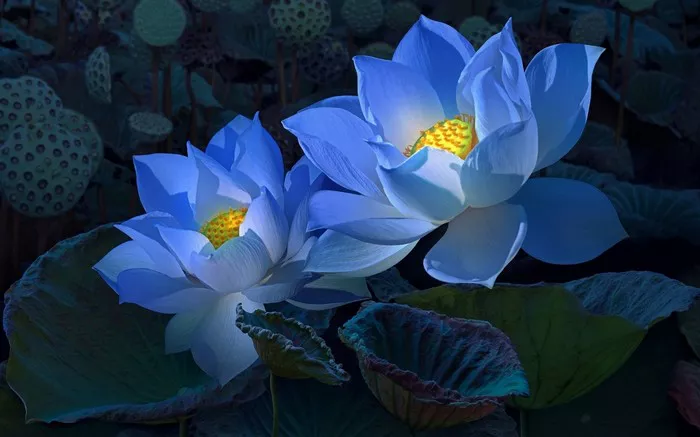In the rich tapestry of symbolism that spans across cultures, few images evoke as much fascination and intrigue as the lotus flower. Revered for its beauty, resilience, and profound spiritual significance, the lotus has held a special place in the hearts and minds of people throughout history. Among the diverse array of lotus varieties, the blue lotus flower stands out as a particularly enigmatic symbol, carrying deep meanings and associations across various traditions and belief systems.
Origins and Cultural Significance
To truly grasp the significance of the blue lotus flower, it is essential to delve into its origins and cultural context. Historically, the lotus has been revered in ancient civilizations such as Egypt, India, China, and the civilizations of Mesopotamia. Each culture imbued the lotus with its own unique symbolism, but common threads of purity, enlightenment, and rebirth run through them all.
In ancient Egypt, the blue lotus (Nymphaea caerulea) held a prominent place in religious and spiritual practices. Known as the “Sacred Lily of the Nile,” it was associated with the sun god Ra and the concept of rebirth. Egyptian mythology depicted the blue lotus as emerging from the primordial waters of creation, symbolizing the emergence of life from chaos. Its intoxicating fragrance and vibrant blue petals made it a symbol of beauty and transcendence.
In Hinduism and Buddhism, the lotus is a powerful symbol of spiritual awakening and enlightenment. The blue lotus, specifically, is often associated with the Hindu deity Vishnu, who is depicted as resting on a bed of blue lotus petals in the cosmic ocean. In Buddhist tradition, the blue lotus represents the victory of the spirit over the senses, as well as the ability to rise above worldly attachments and attain spiritual liberation.
Symbolism and Meanings
The symbolism of the blue lotus flower is multifaceted, encompassing a range of meanings that resonate deeply with the human experience. One of its most prominent associations is with the concept of purity and transcendence. Like the lotus rising from muddy waters to bloom in pristine beauty, the blue lotus symbolizes the journey from darkness to light, from ignorance to enlightenment.
Moreover, the blue lotus is often seen as a symbol of renewal and rebirth. In many cultures, it is believed to possess rejuvenating properties, both physically and spiritually. Its ability to emerge unblemished from the murky depths of the water mirrors the human capacity for transformation and renewal, offering hope and inspiration to those facing adversity or seeking inner growth.
In addition to its spiritual connotations, the blue lotus is also associated with love, passion, and sensuality. In ancient Egypt, it was believed to have aphrodisiac qualities, and it was frequently used in rituals associated with love and fertility. The intoxicating scent of the blue lotus was thought to awaken desire and stimulate the senses, making it a potent symbol of romantic love and passion.
Furthermore, the blue lotus holds deep significance in the realm of mysticism and esoteric wisdom. In various mystical traditions, it is regarded as a sacred plant with the power to induce altered states of consciousness and facilitate spiritual insight. The psychoactive properties of the blue lotus were well-known to ancient civilizations, who used it in religious ceremonies and rituals to commune with the divine and access higher realms of consciousness.
Contemporary Interpretations
While the ancient symbolism of the blue lotus continues to resonate with many people today, its meaning has evolved and adapted to modern contexts. In contemporary spiritual practices, the blue lotus is often used as a tool for meditation and inner exploration. Its calming fragrance and tranquil beauty make it a popular choice for creating sacred spaces and fostering a sense of peace and serenity.
Moreover, the blue lotus has found its way into various forms of art and literature, where it serves as a potent symbol of beauty, transcendence, and the mysteries of the universe. From ancient myths and legends to contemporary novels and films, the blue lotus continues to captivate the imagination and inspire awe and wonder.
In the world of alternative medicine, the blue lotus is gaining recognition for its potential therapeutic benefits. From its calming effects on the nervous system to its purported aphrodisiac properties, it is increasingly being used to promote relaxation, relieve stress, and enhance overall well-being. As interest in natural remedies and holistic healing continues to grow, the blue lotus is likely to become even more prominent in the realm of wellness and self-care.
Conclusion
In conclusion, the blue lotus flower holds a rich tapestry of meanings and associations that span across cultures, religions, and centuries. From its ancient origins in the sacred rituals of ancient civilizations to its contemporary role as a symbol of beauty, transcendence, and spiritual awakening, the blue lotus continues to captivate the human imagination and inspire awe and wonder. Whether admired for its exquisite beauty, revered for its profound spiritual significance, or cherished for its therapeutic properties, the blue lotus remains a timeless symbol of hope, renewal, and the eternal mysteries of life.


